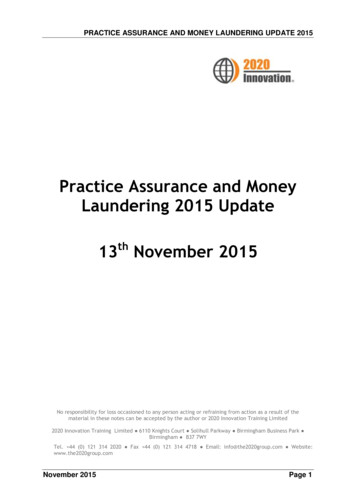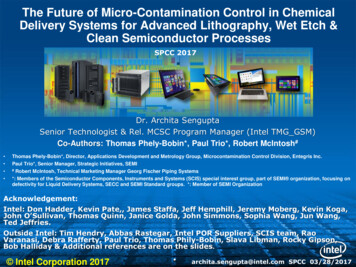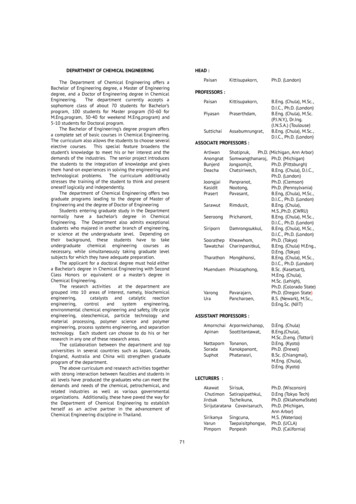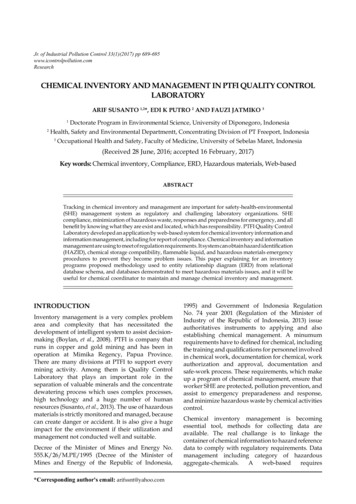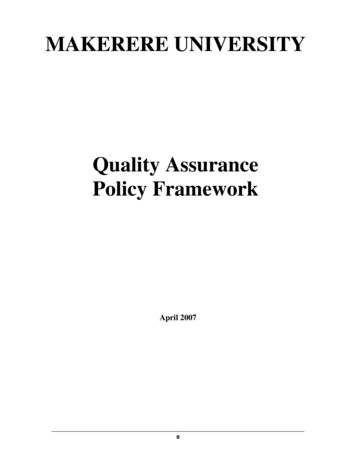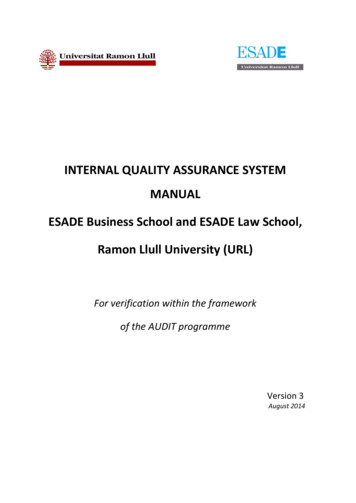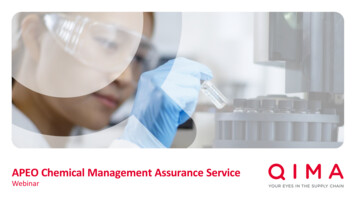
Transcription
APEO Chemical Management Assurance ServiceWebinar
What is APEO?APEO (Alkylphenol Ethoxylates) - a family oforganic compounds with phenolsAlkylphenols are xenoestrogens, a hormonedisruptor, that can mimic the behaviors ofanimal hormonesThey can be very persistent in theenvironment and are very toxic to wildlife,especially aquatic life.info@qima.com2
What is the current legislation for APEO?European Union and many brand names have requirement for APEOThe European Chemicals Agency has enacted a newrequirement - Annex XVII to REACH on textile articles(effective 3 February 2021)Many suppliers and their manufacturers foundthemselves failing the requirementinfo@qima.com3
What are the scope of the restriction?Types of products and requirementNew Textiles Articles (at least 80% textile fibresby weight)Finished Product, Semi-finished Product,Unfinished Product, Component, AccessoriesClothing, Accessories, Interior textiles, Fibres,Yarn, Fabrics, Knitted panelsNPEO found must be less than 0.01% by weightinfo@qima.com4
Where does APEO come from?Common places to find APEODetergents - commonly use in textile materials aswashing and cleaning agentsFragrancesThermoplastic elastomersAntioxidantsOil field chemicalsFire-retardant materialsOther items such as tires, adhesives, coatings, carbonlesscopy paper and high-performance rubber products etc.info@qima.com5
Why are we seeing failure at testing?Testing standards for APEOECHA - Annex XVII to REACH for textile articlesBased on buyers’ requirementsinfo@qima.com6
APEO chemical managementassurance serviceChemical management for brands and suppliersDesigned to assist supplier and manufacturer to fulfill thenew EU and buyers’ APEO requirementsEnsure supply chain complianceFailure analysis for supply chainIdentification of failure root causesCorrective and preventative action planinfo@qima.com7
Overview of APEO chemical management serviceAchieve APEO compliance with the 3 leveled programEach level represents a different level of assuranceWe examine, verify or certify the manufacturing system andproduction siteThe program can also be used by supplier or manufacturer as apreventative action to future potential issue withA demonstration of qualification for suppliers/manufacturersLevel 1 Examination ProgramLevel 2 Verification ProgramLevel 3 Certification Programinfo@qima.com8
Program details – level 1Level 1Assures manufacturer can produce product thatmeet the regulatory and /or client’s requirementsEmploys 2 types of services to assist in theexamination of product compliance1. Sampling (may include Inspection)2. Testinginfo@qima.com9
Program details – level 1Level 1 examination certificateUpon the completion and satisfaction of testingand inspection results based on the followingpass/fail CriteriaLevel 1 Examination Certificate will be issuedseparately after testing reports and inspectionreports are issuedinfo@qima.com10
Program details – level 1Pass/fail criteriaAll testing must be passed:baseline ECHA ANNEX XVII TO REACHAll sampling must be passed:sample must be representative of productionsampling must be on-site at the manufacturerproduction information must be provided (e.g.quantity, start/end date .)samples must be taken at finished product stageideally at warehouseproduction must be 90% complete before samplingsample traceability must be maintained at all timesAll inspection must be passed (if required by the client)info@qima.com11
Program details – level 2Level 2An extension, at a higher level, to the Level 1Examination programFocuses on making sure the manufacturer canproduce compliant productsDemonstrate manufacturer’s production systemAll requirements in the previous program areapplicableOn-site audit will be performed for productionsystem verificationinfo@qima.com1212
Program details – level 2Level 2 verification certificateUpon completion and satisfaction of Testing,Inspection and Audit based on the followingPass/Fail CriteriaLevel 2 Verification Certificate will be issuedseparately after testing reports, inspectionreport and audit report are issuedinfo@qima.com13
Program details – level 2Pass/fail criteriaAll testing, sampling, inspection (if required), audit and follow-up audit(if applicable) must be passedObservation no limitMajor non-compliance 5 ( 5 required a follow-up audit)Major plus minor non-compliance 10 ( 10 required a follow-up audit)Critical non-compliance - not allowedAll non-compliance require submission of CAPinfo@qima.com14
Program details – level 2Corrective actionThe manufacturer is required to conduct correctiveaction immediatelyIf the audit failed, all non-compliance findingsmust be rectified and verified by a follow-up auditAll corrective action must be implemented withina three (3) month periodIf extension is needed, the manufacturer isrequired to contact QIMA with reasonsA full audit will be required if timeline cannot bemet and without proper reasoninginfo@qima.com15
Program details – level 2Follow-up auditWhen initial audit is failed, a follow-up audit isrequiredScheduled when all corrective actions have beenrectifiedFocus on previous non-compliance findingsTypical duration – 1 man day unless many noncompliance findings were presented from previousauditinfo@qima.com16
Program details – level 3Level 3A comprehensive certification programManufacturer will be able to demonstratetheir well-developed quality system withconsistent executionAll requirements detailed in level 1 and 2are applicable, which include testing,inspection with sampling, and auditinfo@qima.com17
Program details – level 3Certification bodyA separate unit who actedindependently, impartially andwithout due influence to approveand grant certificateThe certificate issued is alsoindependent from any test,inspection and audit reports issuedpreviously to the manufacturerChief OperationOfficerOperation managersTestingInspectionAuditingProject managerCertification bodymanagerCertificationdecision makerThe Certification Body reviewinformation and grant the certificateinfo@qima.com18
Program details – level 3Technical fileThe technical file/documentation should contain, but not limited to, the following document:APEO chemical managementassurance level 3 certificationapplication form*Manufacturer’s businessregistration or equivalent*Product name, description andphoto(s)*Test plan(s)*Inspection plan(s)info@qima.comSampling plan(s)*Follow up audit report(s)Audit plan(s)*Failure analysis report(s)All relevant test report(s)Corrective action plan(s)All relevant inspectionreport(s)Other relevant documentAll relevant samplingreport(s)*(*) Are compulsory items.All relevant audit report(s)*19
Program details – level 3Market surveillanceQIMA may organize and perform surveillance of product placed on the marketIf a market surveillance finds nonconformities, the Certification Body, where appropriate, will withdraw thecertificate of conformityinfo@qima.com20
Program details – level 3On-site re-assessmentOnsite re-assessment audit will take place at aninterval within the certification period orimmediately after a market surveillance testingTypical duration - one man dayFocus on previous nonconformitiesIf the re-assessment finds nonconformities, theCertification Body, where appropriate, will withdrawthe certificate of conformityinfo@qima.com21
Review of APEO chemical management serviceAchieve APEO compliance with the 3 leveled programEach level represents a different level of assuranceWe examine, verify or certify the manufacturing system andproduction siteThe program can also be used by supplier or manufacturer as apreventative action to future potential issue withA demonstration of qualification for suppliers/manufacturersLevel 1 Examination ProgramLevel 2 Verification ProgramLevel 3 Certification Programinfo@qima.com22
Beyond chemical management - APEO failure analysisIdentifying root cause with corrective actionAssists manufacturer in the understanding of thefailure, finding root cause and suggesting correctiveactionAdditional product data, production data, testing,inspection and audit may be requiredData analysis will be conductedUnder certain circumstances, true root cause may notbe identifiable due to the lack of information or thelost of failure evidenceinfo@qima.com23
What is Failure Analysis?Root cause identification withcorrective action planFailure Analysis typically includes extensiveinvestigation on design, manufacturingprocess, distribution process, material usageand existing dataFor some incidental cases, the exact rootcause may not be discovered butnonetheless, good indications of what hashappened can always be identifiedinfo@qima.com24
Program details – 3 stagesFailure Analysis of APEOAn effective failure analysis must be structured, organized and mostly involving teamwork. While for consumerproducts, it can be divided into three (3) stages:1. Understanding of the problem2. Investigation to identify root cause3. Analysis and conclusionThe problem has to be clearly identifiedand defined so that an investigation canbe carried outA scientific and statistical approach isemployed that will collect data from eachstage in the product’s life cycle. The datacollected will help determine at whichstage the failure or defect is occurringData collected were analysis to drawconclusion and what has happened.With the possible root cause beingfound, a corrective action can beestablished and implementedinfo@qima.com25
Program details – 9 stepsThe 3 stages can be divided into 9 steps:1. APEO Failure Description2. Information Gathering3. Initial assessmentFailure description provides theinitial failure information.i.4. Formulate hypothesisPhotosii. Sampleiii. Production DataScopei. Consumer ProductAPEOFailureAnalysisServicesii. Textile materials –component, accessory,unfinished, semi-finishedor finished productsiii. APEO failureiv. Involve manufacturinginfo@qima.comiv. Quality Assurance Data5. Established investigation plan6. Data collection via testing,inspection, sampling,auditing, factory quality data,historical data7. Data analysis8. Confirmation of hypothesis26
Program details – 9 steps9. Conclusion and ReportingThe main purpose for failure analysis is todetermine if the issue is a systemic problem orjust and individual accidentAfter a conclusion is drawn, a report detailingthe various steps of failure analysis will beprovided to the manufacturer for further actioninfo@qima.comType of ConclusionEvidenceCall for ActionSystem failureCritical or Major design or qualitysystem failure, no control of APEOor was intentionally addedProduct recall /Stop distributionFrequent incidentalfailureMinor quality issue affecting batch,wrong use of batch material withAPEO contaminationStop distribution /close monitoringInfrequent accidentContamination of APEO due toaccidental non-adherence toproceduresMonitoring / noaction needed27
Program details – next stepCorrective action and next stepQIMA will suggest corrective action planWe will also help manufacturer to implementcorrective and preventive actionsFollow up onsite assessment and testing can beconducted upon completion of corrective andpreventive actionsinfo@qima.com28
Thank you!Email: info@qima.comVisit: www.qima.com
1. APEO Failure Description Failure description provides the initial failure information. APEO Failure Analysis Services Scope i. Consumer Product ii. Textile materials - component, accessory, unfinished, semi-finished or finished products iii. APEO failure iv. Involve manufacturing 3. Initial assessment 4. Formulate hypothesis 5. Established .
